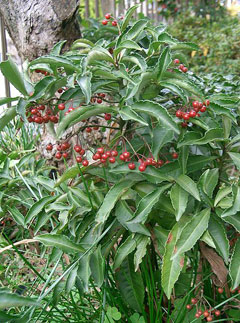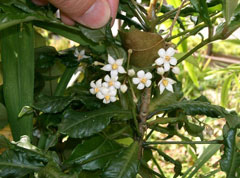 |
|
http://commons.wikimedia.org/wiki/User:KENPEI |
 |
| http://commons.wikimedia.org/wiki/User:KENPEI |
Translate this page:
Summary
An evergreen shrub with attractive red berries, native to east and southeast Asia and parts of India, which grows to 2m (6ft) as an understorey forest plant. The root is anodyne, depurative, febrifuge and used to stimulate blood circulation. Used as an ornamental plant in shady conditions. Bloom Color: White.
Main Bloom Time: Late summer. Form: Rounded, Upright or erect.
Common Names: Australian holly; Christmas berry; coral ardisia; coral berry tree; coral bush; hen's eyes; Hilo holly; scratchthroat; spiceberry. French: arbre à noël; arbre de noël; ardisie crénelée; baie corail; bois de noël. Chinese: zhu sha gen. Germany: gewürzbeere; spitzenblume. Japan: manryo. South Africa: koraalbessieboom (Afrikaans).
Physical Characteristics

 Ardisia crenata is an evergreen Shrub growing to 2 m (6ft) by 2 m (6ft) at a slow rate.
Ardisia crenata is an evergreen Shrub growing to 2 m (6ft) by 2 m (6ft) at a slow rate.
See above for USDA hardiness. It is hardy to UK zone 7. It is in leaf all year, in flower from June to July, and the seeds ripen from September to December. The species is hermaphrodite (has both male and female organs).
Suitable for: light (sandy), medium (loamy) and heavy (clay) soils, prefers well-drained soil and can grow in heavy clay soil. Suitable pH: mildly acid, neutral and basic (mildly alkaline) soils. It can grow in semi-shade (light woodland). It prefers moist soil.
UK Hardiness Map
US Hardiness Map
Synonyms
Plant Habitats
Woodland Garden Dappled Shade; Shady Edge;
Edible Uses
References More on Edible Uses
Medicinal Uses
Plants For A Future can not take any responsibility for any adverse effects from the use of plants. Always seek advice from a professional before using a plant medicinally.
Anodyne Depurative Febrifuge
The root is anodyne, depurative, febrifuge[147, 218]. It is used to stimulate blood circulation[147].
References More on Medicinal Uses
The Bookshop: Edible Plant Books
Our Latest books on Perennial Plants For Food Forests and Permaculture Gardens in paperback or digital formats.

Edible Tropical Plants
Food Forest Plants for Hotter Conditions: 250+ Plants For Tropical Food Forests & Permaculture Gardens.
More

Edible Temperate Plants
Plants for Your Food Forest: 500 Plants for Temperate Food Forests & Permaculture Gardens.
More

More Books
PFAF have eight books available in paperback and digital formats. Browse the shop for more information.
Shop Now
Other Uses
Landscape Uses: Container. Used as an ornamental plant in shady conditions.
Special Uses
References More on Other Uses
Cultivation details
Prefers a well-drained humus rich soil in partial shade in a position sheltered from cold drying winds[200]. We are not sure if this plant is hardy outdoors in Britain. One report says that it is hardy in zone 7 (tolerating temperatures down to between -10 and -15°c) but then goes on to suggest that it needs an essentially frost-free climate and is often grown as an indoor pot plant in Britain[200]. This species is closely related to A. pseudocrispa, from which it differs in having crenate leaves with a distinct marginal vein[266]. There has been some confusion between this species and A. crispa, the name Ardisia crispa was misapplied by de Candolle to Ardisia crenata[266]. Special Features:Attractive foliage, Not North American native, Invasive, Fragrant flowers.
References Carbon Farming Information and Carbon Sequestration Information
Temperature Converter
Type a value in the Celsius field to convert the value to Fahrenheit:
Fahrenheit:
The PFAF Bookshop
Plants For A Future have a number of books available in paperback and digital form. Book titles include Edible Plants, Edible Perennials, Edible Trees,Edible Shrubs, Woodland Gardening, and Temperate Food Forest Plants. Our new book is Food Forest Plants For Hotter Conditions (Tropical and Sub-Tropical).
Shop Now
Plant Propagation
Seed - best harvested when it is ripe in the winter and sown immediately in a greenhouse[1]. Sow stored seed as early in the year as possible. When large enough to handle, prick the seedlings out into individual pots and grow them on in a shady part of the greenhouse for at least their first winter. Plant out into their permanent positions in late spring or early summer, once the plants are 20cm or more tall. Cuttings of half-ripe wood in summer[200]. Grow on in cool, shaded humid conditions until well rooted[200].
Other Names
If available other names are mentioned here
Native Range
TEMPERATE ASIA: China (Anhui Sheng, Zhejiang Sheng, Fujian Sheng, Hunan Sheng, Hubei Sheng, Jiangxi Sheng, Jiangsu Sheng, Guangdong Sheng, Yunnan Sheng, Guangxi Zhuangzu Zizhiqu, Xizang Zizhiqu (southwest), Hainan Sheng), Japan (Honshu (south), Kyushu, Ryukyu Islands, Shikoku), Korea, South, Taiwan TROPICAL ASIA: India (southwest), Myanmar, Thailand, Vietnam, Malaysia, Philippines
Weed Potential
Right plant wrong place. We are currently updating this section.
Please note that a plant may be invasive in one area but may not in your area so it's worth checking.
This plant can be weedy or invasive. An invasive species in parts of the USA (Florida and Hawaii), a number of Pacific Islands, and Australia. As a native it is also invasive in the Philippines, Japan and Taiwan.
Conservation Status
IUCN Red List of Threatened Plants Status : This taxon has not yet been assessed. In Singapore is listed as critically endangered.

Growth: S = slow M = medium F = fast. Soil: L = light (sandy) M = medium H = heavy (clay). pH: A = acid N = neutral B = basic (alkaline). Shade: F = full shade S = semi-shade N = no shade. Moisture: D = dry M = Moist We = wet Wa = water.
Now available:
Food Forest Plants for Mediterranean Conditions
350+ Perennial Plants For Mediterranean and Drier Food Forests and Permaculture Gardens.
[Paperback and eBook]
This is the third in Plants For A Future's series of plant guides for food forests tailored to
specific climate zones. Following volumes on temperate and tropical ecosystems, this book focuses
on species suited to Mediterranean conditions—regions with hot, dry summers and cool, wet winters,
often facing the added challenge of climate change.
Read More
Expert comment
Author
Sims.
Botanical References
58200266
Links / References
For a list of references used on this page please go here
Readers comment